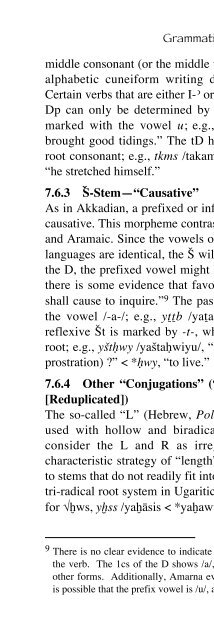A Primer on Ugaritic: Language, Culture, and Literature - enenuru
A Primer on Ugaritic: Language, Culture, and Literature - enenuru
A Primer on Ugaritic: Language, Culture, and Literature - enenuru
Create successful ePaper yourself
Turn your PDF publications into a flip-book with our unique Google optimized e-Paper software.
Grammatical Précis 167<br />
middle c<strong>on</strong>s<strong>on</strong>ant (or the middle vowel in middle weak verbs). The<br />
alphabetic cuneiform writing does not indicate this doubling.<br />
Certain verbs that are either I-} or II-} may indicate the D-stem. The<br />
Dp can <strong>on</strong>ly be determined by c<strong>on</strong>text, though it was probably<br />
marked with the vowel u; e.g., tsûbr /*tubasûsûar/, “you shall be<br />
brought good tidings.” The tD has an prefixed -t- before the first<br />
root c<strong>on</strong>s<strong>on</strong>ant; e.g., tkms /takammasa/ 3ms tD prefix c<strong>on</strong>jugati<strong>on</strong><br />
“he stretched himself.”<br />
7.6.3 SÁ-Stem—“Causative”<br />
As in Akkadian, a prefixed or infixed sû- clearly marks the <strong>Ugaritic</strong><br />
causative. This morpheme c<strong>on</strong>trasts with the prefixed -h in Hebrew<br />
<strong>and</strong> Aramaic. Since the vowels of the derived stems in the Semitic<br />
languages are identical, the SÁ will have the same vowel patterns as<br />
the D, the prefixed vowel might have been /u/ as in Akkadian, but<br />
there is some evidence that favors /a/; e.g., ysûsû}il /yusûasû}ilu/, “he<br />
shall cause to inquire.” 9 The passive SÁp ispresumably marked by<br />
the vowel /-a-/; e.g., yttb /yatatibu/, “he shall be seated.” The<br />
reflexive SÁt ismarked by -t-, which follows the first letter of the<br />
root; e.g., ysûthwy /yasûtahwiyu/, “he shall ask for life (i.e., greet by<br />
prostrati<strong>on</strong>) ?” < *hwy, “to live.”<br />
7.6.4 Other “C<strong>on</strong>jugati<strong>on</strong>s” (“L” [Lengthened] <strong>and</strong> “R”<br />
[Reduplicated])<br />
The so-called “L” (Hebrew, Polel) <strong>and</strong> “R” (Hebrew, Pilpel) are<br />
used with hollow <strong>and</strong> biradical roots, respectively. One may<br />
c<strong>on</strong>sider the L <strong>and</strong> R as irregular forms of the D, but the<br />
characteristic strategy of “length” in the D verb is merely adapted<br />
to stems that do not readily fit into the artificial systematizati<strong>on</strong> of a<br />
tri-radical root system in <strong>Ugaritic</strong> (<strong>and</strong> other NWS languages); i.e.,<br />
for h˙ws, yh˙ss /yah˙aœsis < *yah˙awwis < yaqattil/.<br />
9 There is no clear evidence to indicate the prefix vowel of the derived stems of<br />
the verb. The 1cs of the D shows /a/, but this does not settle the issue for the<br />
other forms. Additi<strong>on</strong>ally, Amarna evidence points to the possibility of /i/. It<br />
is possible that the prefix vowel is /u/, as we have indicated here.


